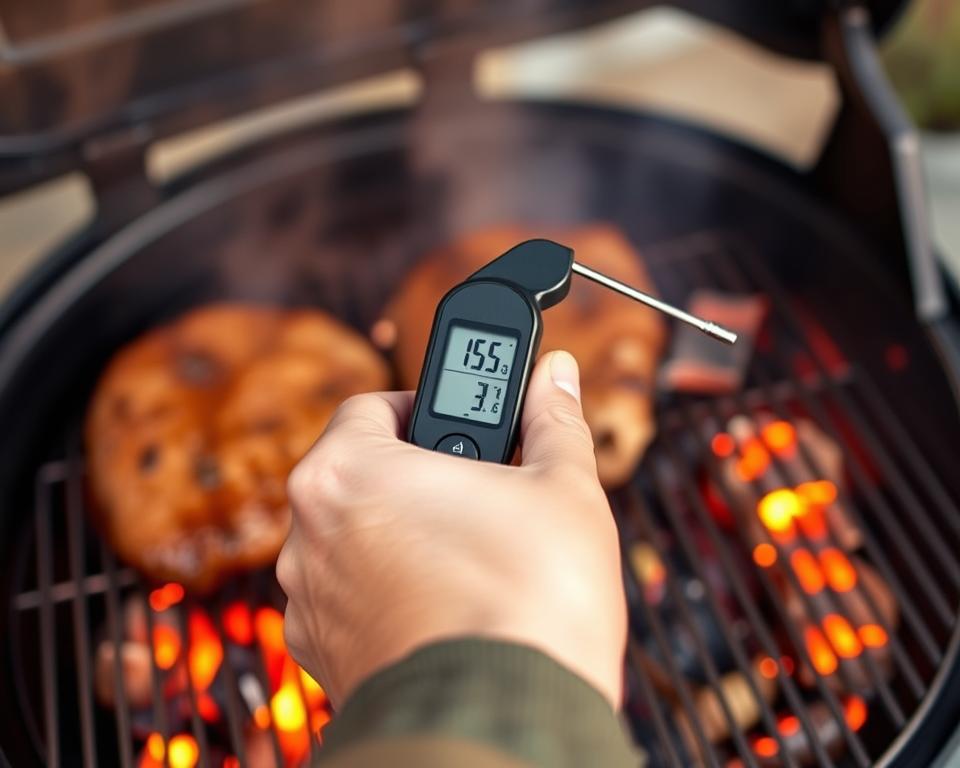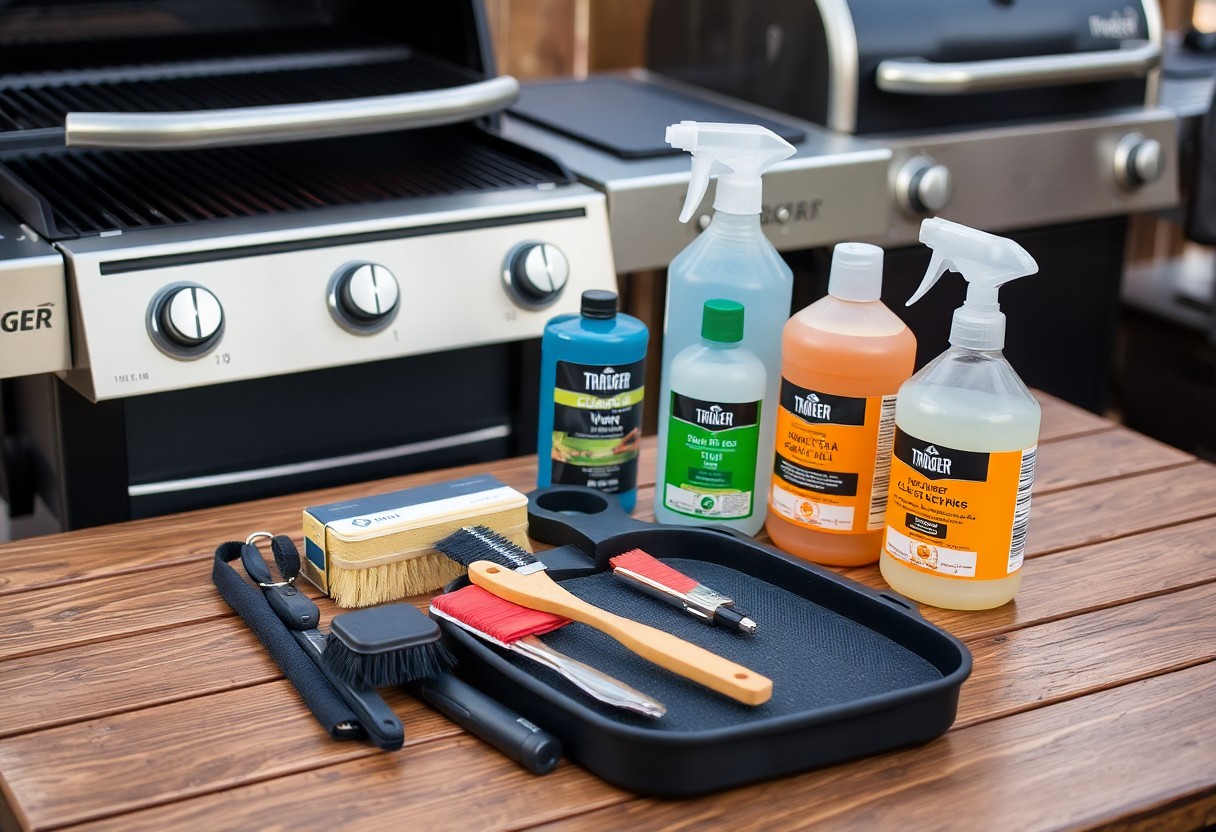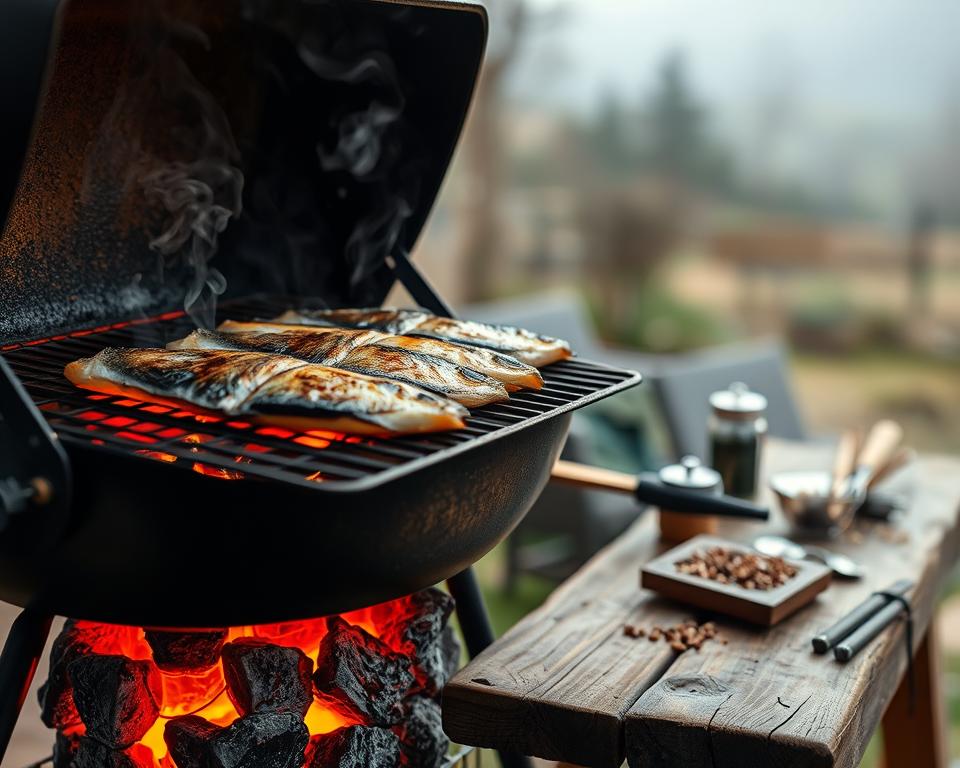A Beginner’s Guide to Understanding Grill Thermometers Grilling is an art, and getting the temperature right is the key to success. Imagine hosting a summer BBQ, only to serve undercooked chicken or overcooked steak. A reliable grill thermometer can prevent such mishaps by ensuring your food reaches the perfect internal temperature. For example, chicken must hit 165°F to be safe, while medium-rare steak should reach at least 135°F1.
Modern thermometers, like the ThermoPro TP972, make grilling easier. This wireless device has a Bluetooth range of up to 600 feet, allowing you to monitor temperatures remotely1. With two color-coated probes, it can track two ingredients simultaneously, ensuring everything cooks evenly. Plus, its IP67 waterproof rating means it’s easy to clean after use1.
Accurate temperature readings not only ensure food safety but also enhance flavor. Whether you’re using a digital, wireless, or hood-mounted thermometer, precise monitoring helps avoid overcooking and ensures consistent results. For instance, pork should reach 145°F, followed by a resting period to lock in juices2.
Key Takeaways
- Grill thermometers ensure food reaches safe internal temperatures.
- Wireless models like the ThermoPro TP972 offer convenience and accuracy.
- Monitoring temperatures prevents overcooking and enhances flavor.
- Different meats require specific internal temperatures for safety and taste.
- Probe thermometers allow continuous monitoring during cooking.
Understanding Grill Thermometers: Fundamentals and Benefits
Temperature is the cornerstone of achieving perfectly grilled meals. Whether you’re cooking chicken, steak, or vegetables, maintaining the right heat ensures both safety and flavor. Grill thermometers play a vital role in this process by providing accurate readings of internal temperatures.
The Role of Temperature in Perfect Grilling
Grilling relies on precise temperature control to bring out the best in your food. For example, chicken must reach 165°F to be safe, while medium-rare steak should hit 135°F3. Using a thermometer probe helps monitor these levels, ensuring even cooking and preventing undercooked or overcooked meals.
Charcoal grills can reach temperatures above 700°F, while gas grills heat up in about 10 minutes4. These variations highlight the importance of choosing the right thermometer for your setup. Wireless models like the ThermoPro TP972 offer real-time monitoring, making it easier to adjust heat levels as needed.
How Accurate Readings Enhance Food Safety and Flavor
Accurate temperature readings are essential for both safety and taste. Undercooked meats can pose health risks, while overcooking can ruin texture and flavor4. A reliable thermometer ensures your food reaches the ideal internal temperature, locking in juices and enhancing the overall experience.
For example, pork should be cooked to 145°F, followed by a resting period to retain moisture3. Digital and wireless thermometers simplify this process by providing continuous updates, allowing you to make adjustments in real-time.
| Meat Type | Ideal Internal Temperature |
|---|---|
| Chicken | 165°F |
| Steak (Medium-Rare) | 135°F |
| Pork | 145°F |
By understanding the fundamentals of grill thermometers, you can elevate your cooking game. Whether you’re a seasoned griller or just starting, these tools are indispensable for achieving consistent, delicious results.
A Beginner’s Guide to Understanding Grill Thermometers
Key Features and Technologies in Modern Grill Thermometers
Modern grill thermometers have revolutionized the way we cook, offering precision and convenience. With features like wireless connectivity, digital displays, and advanced probe technology, these tools make it easier than ever to achieve perfect results. Whether you’re grilling chicken, steak, or pork, these innovations ensure consistent temperature control and food safety5.
Wireless Connectivity and Remote Monitoring
Wireless thermometers like the ThermoPro TP20 allow you to monitor temperature from up to 300 feet away5. This feature is especially useful for multitasking or entertaining guests while grilling. Models such as the ThermoWorks Smoke maintain a connection up to 350 feet, ensuring you never lose track of your food’s progress6.
Bluetooth-compatible thermometers, like the ThermoWorks BlueDot, offer a signal range of approximately 50 yards6. These devices often include custom alerts, so you’re notified immediately if the temperature deviates from the desired range.
Built-in, Hood-mounted, and Infrared Variations
Built-in and hood-mounted thermometers are ideal for those who prefer a permanent solution. These models provide continuous readings without the need for separate probes. Infrared thermometers, like the Etekcity 1080, measure surface heat with precision, making them perfect for quick checks5.
Infrared models are particularly useful for grilling vegetables or checking the temperature of your grill’s surface. They eliminate the need for direct contact, reducing the risk of contamination.
User-Friendly Digital Displays and Custom Alerts
Digital displays have become a standard feature in modern thermometers. The ThermoPro TP03H, for example, features a large LCD screen for easy visibility5. Custom alerts ensure you’re notified when your food reaches the desired temperature, preventing overcooking or undercooking.
Many models, like the ThermoWorks Smoke, allow you to set multiple alarms simultaneously6. This is particularly helpful when cooking different types of meat, such as chicken and pork, which require specific internal temperatures for safety5.
| Feature | Benefit |
|---|---|
| Wireless Connectivity | Monitor temperature remotely |
| Infrared Technology | Measure surface heat without contact |
| Custom Alerts | Prevent overcooking and ensure safety |
“A good thermometer is the secret to perfect grilling. It’s not just about safety—it’s about flavor.”
With these advanced features, modern grill thermometers simplify the cooking process while ensuring consistent results. Whether you’re a seasoned griller or just starting, these tools are indispensable for achieving delicious, perfectly cooked meals.
How to Use a Grill Thermometer Effectively
Using a grill thermometer effectively can transform your cooking experience. It ensures your food reaches the ideal internal temperature, enhancing both safety and flavor. Whether you’re grilling chicken, steak, or pork, following the right steps guarantees consistent results.

Step-by-Step Guide to Proper Probe Placement and Preheating
Start by preheating your grill to the desired heat level. For most meats, a medium to high setting works best. Allow the grill to heat for 10-15 minutes to ensure even cooking7.
Next, insert the probe into the thickest part of the meat, avoiding bones or fat. This ensures accurate readings. For example, chicken should reach 165°F, while medium-rare steak requires 135°F8.
Clean the thermometer between uses to prevent cross-contamination. This is especially important when switching between different types of meat9.
A Beginner’s Guide to Understanding Grill Thermometers
Techniques for Monitoring and Adjusting Temperature in Real-Time
Modern thermometers like the ThermoPro TP972 allow real-time monitoring. Its Bluetooth range of 600 feet lets you track temperature remotely8. Use the digital display or smartphone app to stay updated.
Adjust the grill’s heat as needed to maintain the desired level. For example, sear steaks at high heat, then lower the temperature to finish cooking7.
Remember, carryover cooking can raise the internal temperature by a few degrees after removal from the grill. Factor this into your final reading8.
- Preheat the grill for 10-15 minutes to ensure even cooking7.
- Insert the probe into the thickest part of the meat for accurate readings9.
- Use real-time monitoring tools to adjust heat levels as needed8.
- Account for carryover cooking to avoid overcooking8.
By following these steps, you’ll master the art of using a grill thermometer. It’s the key to achieving perfectly cooked meals every time.
A Beginner’s Guide to Understanding Grill Thermometers
Mastering grilling requires attention to detail, especially when it comes to temperature control. Beginners often make mistakes that can lead to undercooked or overcooked meals. By understanding these pitfalls and adopting best practices, you can achieve consistent, delicious results every time.
Frequent Mistakes and How to Avoid Them
One common error is improper probe placement. Inserting the thermometer into the wrong part of the meat, such as near a bone or fat, can result in inaccurate readings. Always place the probe in the thickest part of the meat for the most reliable results10.
Another mistake is rushing temperature readings. Instant-read thermometers take 10-20 seconds to provide accurate data, while dial thermometers may require up to two minutes11. Patience ensures your food reaches the ideal internal temperature.
Carryover cooking is often overlooked. Meat continues to cook after being removed from the grill, raising its internal temperature by a few degrees. Factor this into your final reading to avoid overcooking10.
Best Practices for Perfect Grilling
Preheat your grill for 10-15 minutes to ensure even heat distribution. This step is crucial for achieving consistent results10.
Use a high-quality thermometer to monitor temperature in real-time. Wireless models like the ThermoPro TP972 offer Bluetooth connectivity, allowing you to track temperature from up to 600 feet away10.
Clean your thermometer after each use to prevent cross-contamination. This is especially important when switching between different types of meat, such as chicken and pork12.

| Mistake | Best Practice |
|---|---|
| Improper probe placement | Insert probe into the thickest part of the meat |
| Rushing temperature readings | Wait for accurate readings (10-20 seconds for instant-read) |
| Ignoring carryover cooking | Factor in a 3-5°F rise after removing from grill |
By avoiding these common mistakes and following best practices, you can elevate your grilling game. Consistent temperature monitoring ensures food safety and enhances flavor, making every meal a success.
Conclusion
Achieving perfectly grilled meals relies heavily on precise temperature control. A reliable thermometer ensures your food reaches the ideal internal heat, enhancing both safety and flavor. Modern advancements, like wireless connectivity and digital displays, make monitoring easier than ever13.
Proper probe placement and preheating protocols are essential for accurate readings. Insert the probe into the thickest part of the meat, avoiding bones or fat, for consistent results14. Real-time adjustments help maintain the desired temperature, preventing overcooking or undercooking.
Investing in a high-quality thermometer elevates your grilling experience. By avoiding common mistakes and following best practices, you can achieve delicious, perfectly cooked meals every time. Explore more tips and techniques to master the art of grilling.





Leave a Reply